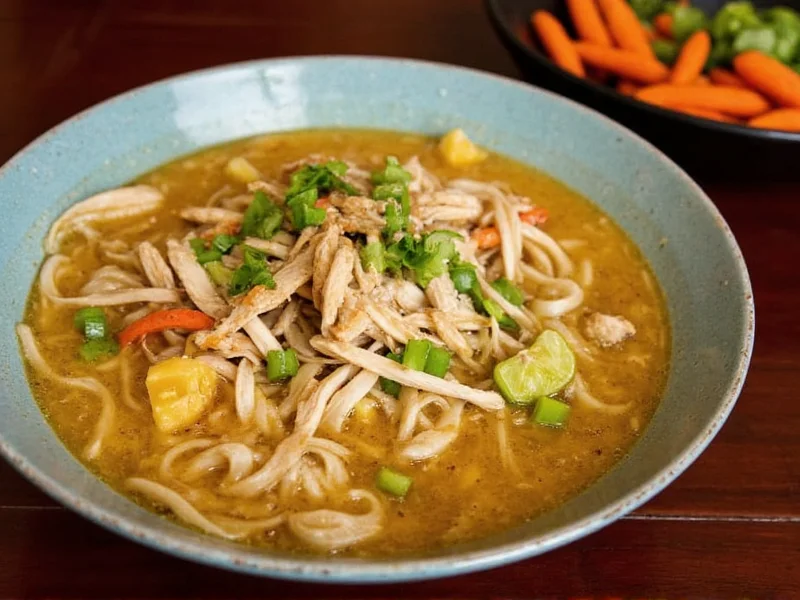Mrs. Grass chicken noodle soup represents an important chapter in American convenience food history. This iconic instant soup mix captured household attention during the 1970s and 1980s with its promise of quick, comforting meals. Understanding this product requires examining its formulation, historical context, and how it compared to contemporary alternatives in the rapidly evolving soup market.
Historical Development and Market Position
General Foods launched the Mrs. Grass brand in 1971 as part of the growing convenience food movement. The chicken noodle variety quickly became the flagship product, distinguishing itself from competitors through its powdered mix format rather than canned preparation. During its peak popularity in the 1980s, Mrs. Grass occupied a unique market position between traditional canned soups and emerging instant ramen products.
The brand's name intentionally evoked homestyle cooking, suggesting a personal touch despite being a mass-produced product. Marketing materials emphasized the "just add water" simplicity while maintaining the perception of homemade quality. This positioning resonated with time-pressed households seeking convenient yet seemingly wholesome meal options.
Product Composition and Preparation Method
Mrs. Grass chicken noodle soup consisted of a powdered base containing dehydrated chicken broth components, flavor enhancers, and fine egg noodles. The preparation process required only boiling water, making it significantly faster than traditional soup preparation methods. This instant format created a lighter broth compared to canned alternatives, with distinctive thin noodles that maintained texture better than many contemporary instant products.
| Key Ingredient | Function | Notable Characteristics |
|---|---|---|
| Dehydrated chicken broth base | Flavor foundation | Contained hydrolyzed vegetable protein for umami enhancement |
| Thin egg noodles | Texture component | Finer cut than typical canned soup noodles |
| Dehydrated vegetables | Visual and flavor elements | Limited variety (primarily carrots and celery) |
| Salt and seasonings | Flavor balance | Higher sodium content than modern standards |
Comparison with Contemporary Soup Products
When evaluating Mrs. Grass chicken noodle soup versus Campbell's and other brands, several distinctive characteristics emerge. Unlike Campbell's condensed soups requiring liquid addition, Mrs. Grass functioned as a complete mix. Compared to Lipton's soup mixes, Mrs. Grass offered a more substantial noodle component and richer chicken flavor profile.
The texture difference between Mrs. Grass chicken noodle soup and canned alternatives represented a significant distinction. While canned soups often featured thicker broths and larger noodle pieces, Mrs. Grass created a lighter, clearer broth with finer noodles that maintained integrity better during storage. This characteristic made it particularly appealing for those seeking a less heavy soup experience.
Creative Usage Applications
Beyond basic preparation, culinary enthusiasts developed numerous applications for Mrs. Grass chicken noodle soup mix. Many home cooks discovered its versatility as a flavor base for casseroles, sauces, and gravies. The powdered format made it particularly useful as a seasoning component in recipes requiring dry ingredients.
Popular creative applications included:
- Using the mix as a seasoning for roasted chicken
- Incorporating into biscuit or dumpling dough for added flavor
- Creating quick pot pie fillings by combining with cooked vegetables and protein
- Enhancing store-bought broth for more complex soup bases
Nutritional Profile Analysis
Understanding the nutritional information for Mrs. Grass chicken noodle soup requires contextualizing it within historical dietary standards. A single serving (prepared according to package directions) typically contained approximately 70-90 calories, with 2-3 grams of protein and 1000-1200mg of sodium. The carbohydrate content primarily came from the noodles, while fat content remained minimal.
Modern consumers examining Mrs. Grass chicken noodle soup nutrition facts would note significantly higher sodium levels compared to contemporary standards. The product lacked substantial vegetable content beyond minimal dehydrated pieces, and the protein content remained relatively low compared to homemade chicken soups featuring actual meat pieces.
Brand Evolution and Discontinuation
The Mrs. Grass brand underwent several ownership changes that ultimately led to its discontinuation. After General Foods introduced the product, Kraft acquired the company in 1989, maintaining the brand through the 1990s. Market analysis suggests declining sales and changing consumer preferences toward lower-sodium options contributed to the brand's eventual phase-out around 1998-2000.
While the original Mrs. Grass chicken noodle soup is no longer manufactured, some specialty food producers have created similar products that echo its format and preparation method. These modern alternatives often address historical limitations by reducing sodium content and increasing vegetable components while maintaining the convenience factor that made the original product popular.
Legacy and Cultural Impact
Mrs. Grass chicken noodle soup left a lasting impression on American food culture, particularly among those who experienced its peak popularity. The product represented an important transitional phase in convenience food development, bridging the gap between traditional canned goods and modern instant meal solutions.
Food historians note that Mrs. Grass chicken noodle soup ingredients reflected the technological capabilities and consumer expectations of its era. Its distinctive flavor profile and preparation method created nostalgic associations for many consumers, explaining the continued interest in the discontinued product decades after its market withdrawal.











 浙公网安备
33010002000092号
浙公网安备
33010002000092号 浙B2-20120091-4
浙B2-20120091-4